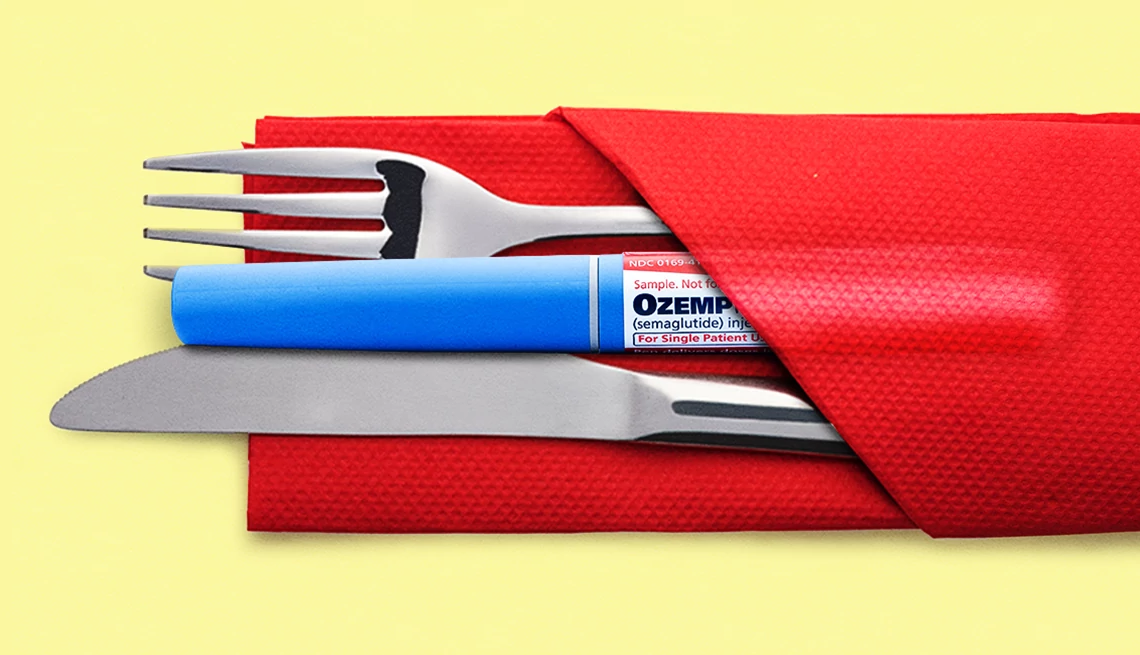AARP Hearing Center


Stephanie Al-Zubaidy learned the hard way about the side effects of GLP-1 medications.
Shortly after she started getting semiglutide injections for weight loss last year, the 54-year-old from Charlotte, N.C., went to trivia night at a local bar and indulged in chicken wings, pizza and fried jalapeno poppers — only to end up vomiting.
"I was very sick after that, but that was my own fault,” she said.
Al-Zubaidy is among a growing number of older adults taking Ozempic or another GLP-1 drug — and learning how to navigate the side effects.
About 1 in 8 adults say they have taken one of the medications for weight loss or a chronic condition such as Type 2 diabetes, according to a May 2024 KFF poll. That includes about 1 in 10 adults ages 65 and older.
But the medications — which include those sold under brand names Ozempic, Wegovy, Mounjaro and Zepbound — can come with some uncomfortable and potentially risky side effects, including nausea, diarrhea, vomiting, constipation and dehydration, as well as bone and muscle loss.
Most people experience side effects
About 80 percent of adults taking tirzepatide or semiglutide, the active ingredients in the most commonly prescribed GLP-1s, experienced at least one side effect, according to a 2024 review study published in the journal Obesity Pillars.
The side effects are worse just after starting treatment and in the days after increasing the dose.
Fortunately, there are ways to mitigate those effects, and it starts with what and how you eat, says Alexandra Sowa, an obesity medicine physician and author of The Ozempic Revolution, a user guide for people taking the drug.
Eating the right diet while taking GLP-1 medications is especially important for older adults, who are already at higher risk for bone and muscle loss, Sowa says.
Combat side effects by eating right
More than 70 percent of adults over age 18 have tried to lose weight, including 83 percent of women age 50-plus, according to a November 2024 AARP poll of more than 3,500 U.S. adults.
Available only with a prescription, GLP-1s have generated a lot of buzz for their ability to slow digestion and suppress appetite, making weight loss easier. Research shows the once-weekly injections can help people lose 10 to 20 percent of their body weight.
Studies have also linked the drugs to a host of other benefits, including a lower risk of heart attacks, strokes, dementia, clotting disorders, addiction and sleep apnea.
However, studies indicate 50 to 72 percent of patients discontinue the drugs within a year, often because of the side effects.
Sowa says people don’t realize those problems can be managed. “People assume that they need to feel unwell (on these medications), but that’s not how these meds should work,” Sowa says. “I truly believe that people just need the right guidance.”
Al-Zubaidy says adjusting her diet was key to managing the side effects of the medication.
By boosting her protein intake, drinking more water and taking fiber and other supplements, she says she has been able to manage the side effects and reap the rewards of the medication — losing more than 30 pounds, feeling more energetic and even improving her joint pain.
“I feel better,” she says. “You know, anytime you lose weight, you feel better.
Here, we’ve compiled tips from experts about what to eat, how to eat and how to exercise to minimize the side effects of taking a GLP-1 medication:
1. Make every bite count
If you’re taking Ozempic or Wegovy, your appetite will decrease, and food stays in your stomach longer, so you’re naturally going to eat less, says Ron Evans, a molecular biologist who researches metabolic disease at the Salk Institute for Biological Studies.
To prevent nutritional deficiencies, “it's really important to make sure that the food that you're eating is of very high nutritional quality,” he says.
Focus on whole, minimally processed foods, he says: “Think about how your grandmother was eating 50 years ago.”
That’s especially important for older adults, who are more prone to nutritional deficiencies because of age-related changes in nutrient metabolism and absorption.
Some doctors also recommend taking supplements such as Vitamin D, calcium and a multivitamin while you’re on a GLP-1 medication to ensure you are meeting your nutritional needs.




































































More From AARP
Got a Minute? 5 Easy Exercises to Try Now
If you only have time for one exercise, fitness experts say, do this one
What Is the Mediterranean Diet?
Explore the diet's health benefits (including weight loss) and what's on the menu.
25 Foods That Won't Cause Weight Gain
Eat these to your heart's content